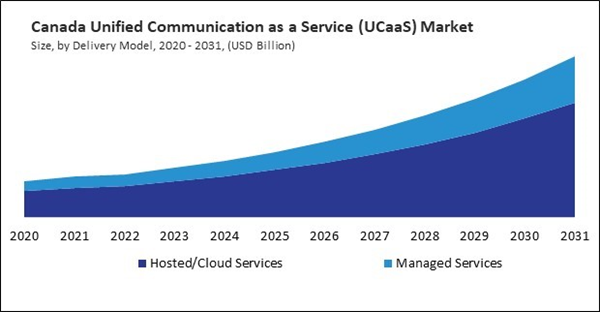The US market dominated the North America Unified Communication as a Service (UCaaS) Market by country in 2023, and is expected to continue to be a dominant market till 2031; thereby, achieving a market value of $21.85 billion by 2031. The Canada market is experiencing a CAGR of 16.1% during 2024-2031. Additionally, the Mexico market is expected to exhibit a CAGR of 15.1% during 2024-2031.
One of the major advantages of UCaaS is its scalability, which makes it an attractive option for businesses of all sizes. UCaaS operates on a subscription model, which enables businesses to pay for the services they require without incurring excessive capital expenses, in contrast to on-premise communication systems that necessitate substantial upfront investments in hardware and infrastructure.
Moreover, this adaptability allows companies to expand their communication tools in accordance with their changing requirements, rendering UCaaS particularly appealing to small and medium-sized enterprises (SMEs). Large enterprises also benefit from the scalability of UCaaS, as they can easily add or remove users, expand features, and adjust their plans according to changes in the workforce or organizational structure. This adaptability is essential in today’s fast-paced business environment, where organizations must remain agile and responsive to changing market demands.
North America is a leading Unified Communication as a Service (UCaaS) market, driven by a strong digital infrastructure, high adoption rates of cloud technology, and a workforce increasingly inclined towards hybrid and remote work models. Companies across industries are prioritizing investments in communication tools that ensure seamless connectivity, collaboration, and productivity. The U.S. telecommunications infrastructure is one of the most advanced, which enables high-quality, reliable UCaaS solutions.
List of Key Companies Profiled
- BT Group plc
- Verizon Communications, Inc.
- Cisco Systems, Inc.
- Microsoft Corporation
- Zoom Video Communications, Inc.
- IBM Corporation
- NEC Corporation
- AT&T, Inc. (AT&T Intellectual Property)
- Google LLC
- 8x8, Inc.
Market Report Segmentation
By Delivery Model
- Hosted/Cloud Services
- Managed Services
By Enterprise Type
- Large Enterprise
- Small & Medium Enterprises (SMEs)
By Component
- Telephony
- Conferencing
- Collaboration
- Unified Messaging
- Others
By Vertical
- IT & Telecommunications
- BFSI
- IT-enabled Services (ITeS)
- Education
- Healthcare
- Retail & Consumer Goods
- Government & Defense
- Others
By Country
- US
- Canada
- Mexico
- Rest of North America
Table of Contents
Companies Mentioned
Some of the leading companies profiled in this North America Unified Communication as a Service (UCaaS) Market report include:- BT Group plc
- Verizon Communications, Inc.
- Cisco Systems, Inc.
- Microsoft Corporation
- Zoom Video Communications, Inc.
- IBM Corporation
- NEC Corporation
- AT&T, Inc. (AT&T Intellectual Property)
- Google LLC
- 8x8, Inc.
Methodology

LOADING...









